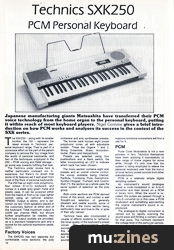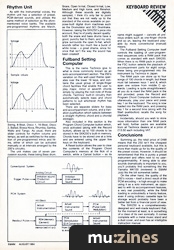Magazine Archive
Home -> Magazines -> Issues -> Articles in this issue -> View
Technics SXK250 | |
PCM Personal KeyboardArticle from Electronics & Music Maker, August 1984 | |
Far-Eastern giants Matsushita have now transferred their PCM-encoded instrument voices from console organs to personal keyboards. Nigel Gomme analyses how elegantly the transition has been accomplished.
Japanese manufacturing giants Matsushita have transferred their PCM voice technology from the home organ to the personal keyboard, putting it within reach of most keyboard players. Nigel Gomme gives a brief introduction on how PCM works and analyses its success in the context of the SXK series.

The SXK250 - along with its smaller brother, the 150 - represent the latest arrivals in Technics' personal keyboard range. They're part of a conscious effort on the part of the parent company to remove the 'toy' image from the world of personal keyboards, and two of the techniques employed in the 250 - PCM voicing and RAM storage - go some way towards fulfilling that task.
The Technics under review here is neither particularly compact nor inexpensive, but there's no doubt that some of its features set it well apart from most of the flock of personal keyboards.
The 250 has an eight-note polyphonic, four octave (C-to-C) keyboard, and comes in a sleek grey-green metal and plastic case. It can be powered either from the mains or from a car cigar lighter socket using an optional adaptor, RP9550. Output is stereo, and is delivered via two 12cm speakers placed in the customary fashion at either end of the keyboard. Total maximum output is 2x5W per channel RMS, but should further amplification be needed, two RCA-type output sockets are provided, as is a standard headphone jack and a socket for the optional expression pedal, SZE1.
Factory Voices
The SXK250 has two separate but combinable voice sections: the poly orchestral and solo synthesiser presets.
The former bank houses eight preset polyphonic tones, all with adjustable sustain. These are Organs 1 and 2, String Ensemble, Brass, Accordion, Guitar, Piano and Harpsichord.
Presets are selected using four pushbuttons and a Bank switch, the latter incorporating an LED to indicate which bank has been chosen.
The mono section contains eight solo presets and an overall volume control, the voices available being Clarinet, Panflute, Trombone, Flute, Saxophone, Synthe-Chopper, Trumpet, and Cosmic Wah (?!): the section as a whole uses the same system of selection as the poly group.
Both voice sections are PCM-derived (more of this anon), and contain a well thought-out selection of generally pleasant and usable sounds, some of the voices in the mono section being particularly clear and true-to-life, in spite of their silly names!
Technics have also incorporated a couple of effects systems to 'enhance' the tonal quality of the keyboard's preset voices. The chorus/celeste facility succeeds to a fair degree in achieving this enhancement, particularly when applied to the Piano and Brass voicings, but the organ tremolo also provided sounded rather unconvincing, though I suppose someone somewhere will find a use for it.

PCM

Pulse Code Modulation is not a new process: in fact, Technics themselves have been applying it successfully to their range of home organs for some while, though it's only now that the system is being employed to relieve the personal keyboard user from the horror of most factory preset sounds from other manufacturers.
PCM is a relatively simple digital sampling system.
An instrument's sound (analogue wave) is code-modulated in an A-to-D converter and then stored on a ROM in binary form. When the sound is recalled, the pulses are passed through a D-to-A converter (or in this case, a PCM modulator) and something approaching the original instrument's sound is reproduced.
The analogue-to-digital conversion is carried out by rapidly scanning the sound wave and finding a numeric value for that wave. The numbers represent the voltage level of the particular sample, as shown in the diagram. The sample illustrated has one value of three (apertaining to a three-volt level) and another of four, relating to a four-volt level. These numbers are converted into binary and then stored in memory.
Rhythm Unit
As with the instrumental voices, the rhythm unit has a selection of preset, PCM-derived sounds, and utilises the same method of selection as the aforementioned voice banks. The available pre-programmed rhythms are March, Swing, 8-Beat, Disco 1, 16-Beat, Disco 2, Ballad, Bossa Nova, Rhumba, Samba, Waltz and Tango. As usual, there are slider controls for rhythm volume and tempo, as well as switches for the selection of pre-programmed intros and fill-ins, either of which can be activated manually or at intervals arranged by the 250's circuitry.
The unit makes use of seven percussion sounds, these being Bass drum, Snare, Open hi-hat, Closed hi-hat, Low, Medium and High toms, and Rimshot. Although these sounds are digitally sampled, I think it's only fair to point out that they are not really up to the standard of the voices available on purpose-built digital drum machines such as the Drumulator and SCI Drumtraks. However, taking the SXK250's price into account, they're of pretty decent quality: both the snare and bass drums have a good, punchy feel to them, and my only gripe surrounds the open hi-hat, which sounds rather too much like a burst of white noise - a great shame, since for once that isn't the way the sound has been created!
Fullband Setting Computer
This is the name Technics give to what is more commonly known as an auto-accompaniment section. The 250's variation on this well-used theme operates over the lower 19 keys, and contains the usual group of single-finger chord facilities that enable the user to play major, minor or seventh chords simply by playing the root note of those chords. Technics' built-in circuitry then automatically selects bass and chord patterns to suit whichever rhythm has been selected.
There are separate sliders for bass and accompaniment volume, and a Variation pushbutton which selects between a straight rhythmic chord and a chordal arpeggio.
Also included in this section is the Program Chord Computer button which, once activated (along with the Record button), allows up to 100 chords to be stored in the SXK250's built-in memory. Chords have to be stored one at a time and are entered using the upper five keys on the keyboard.
A Reset button allows the user to clear the contents of the Program Chord Computer's memory at the flick of a switch, while a Cancel button - as its name might suggest - cancels all previous orders such as one-finger chords and so on, leaving the keyboard playable by more conventional (manual) means.
The Fullband Setting Computer itself controls the loading of user-programmed sequences onto a RAM pack that comes as standard with each SXK250. When there is no RAM pack in position, the FSC button selects the playback of accompaniment parts for eight songs, these being pre-programmed into the instrument by Technics in Japan.
The RAM pack can store up to four songs of 100 chords in length, but these must fall between keys 1 and 8, which span one octave from middle C upwards. Loading is quite straightforward: all you do is insert the RAM pack in the slot provided, press the Record and Program Chord Computer buttons simultaneously, play your piece and press key 1 on the keyboard. The song is now loaded into the RAM pack, and pressing key 1 for a second time (along with the Start pushbutton) recalls the song for playback.
Incidentally, should you wish to store more information than one RAM pack will hold, further packs are available from all Technics dealers at a price of £13.50 each including VAT.
Conclusions
Summing up, the retail price of £499 means that the 250 isn't the cheapest personal keyboard available, but this is more than made up for by the quality of the preset voices. However, it should be remembered that this is purely a preset instrument and offers next to no user-programmability. If being able to alter sounds dramatically is important to you, you'll probably find something like the Yamaha MK100 (reviewed in E&MM July) fits the bill somewhat better.
On the other hand, the quality of the 250's voices - itself a direct result of the PCM encoding - is high enough to make using it as a solo instrument, as opposed to with its accompaniment features, a very real possibility, while the RAM loading is undoubtedly a handy feature, even if using ordinary cassette tape for storage would probably have been a better bet from a financial point of view.
The SXK250 is a comprehensively-designed and well-made keyboard that, for the moment at least, is in something of a class of its own sonically. It comes complete with a metal music stand and a dust cover, and even has an intelligible instruction manual.
The SXK250 carries an RRP of £449 including VAT, and further details can be obtained from Panasonic/Technics, (Contact Details).
Also featuring gear in this article
Publisher: Electronics & Music Maker - Music Maker Publications (UK), Future Publishing.
The current copyright owner/s of this content may differ from the originally published copyright notice.
More details on copyright ownership...
Gear in this article:
Review by Nigel Gomme
Help Support The Things You Love
mu:zines is the result of thousands of hours of effort, and will require many thousands more going forward to reach our goals of getting all this content online.
If you value this resource, you can support this project - it really helps!
Donations for April 2024
Issues donated this month: 0
New issues that have been donated or scanned for us this month.
Funds donated this month: £7.00
All donations and support are gratefully appreciated - thank you.
Magazines Needed - Can You Help?
Do you have any of these magazine issues?
If so, and you can donate, lend or scan them to help complete our archive, please get in touch via the Contribute page - thanks!







